Country of Service: Mauritania, Mali
Dates in Service: 1989-1991
Access: No restrictions
Collection Size: 1 short story excerpt
Document Types

Country of Service: Mauritania, Mali
Dates in Service: 1989-1991
Access: No restrictions
Collection Size: 1 short story excerpt
Document Types
Country of Service: Colombia
Dates in Service: 1962-1964
Service Type: Education, physical education teacher
Keywords: Physical Education, Newspapers
Access: No restrictions
Collection Size: 84 files and .01 linear feet
Document Types
Country of Service: India
Service Type: Agriculture extension
Dates in Service: 1965-1967
Accession Date: March 11, 2021
Access: No restrictions
Collection Size: 66 files
Document Types
Country of Service: Ecuador
Dates in Service: 1966-1968
Accession Date: July 6, 2021
Access: No restrictions
Collection Size: 1 archived blog
Document Types
Country of Service: Philippines
Service Type: Elementary School English Teacher
Dates in Service: 1961-1963
Keywords: Community Development, Education, Literacy, Youth, Judaism
Accession Date: May 7, 2021; May 31, 2022
Access: no restriction
Collection Size: .26 linear feet (located in small collections)
Document Types
Digital Surrogates
Finding Aid
Country of Service: Malaysia
Place of Service: Sandakan
Service Type: High School Teacher; Founding Member of Returned Peace Corps Volunteers of New Jersey
Dates in Service: 1973-1976
Keywords: Community Development, Education, Health, Library Literacy, Youth
Accession Date: April 16, 2021
Access: no restrictions
Collection Size: .01 linear feet (located in small collections)
Document Types
Finding Aid
Country of Service: Botswana
Place of Service: Mahalapye
Service Project: Middle School Teacher, Developmental & Social Studies
Dates in Service: 1980-1982
Keywords: Community Development, Education, Health, HIV/AIDS, Literacy, Youth
Accession Date: March 24, 2021
Access: no restrictions
Collection Size: .25 linear feet (located in small collections)
Document Types
Digital Files
Digital Surrogates
Related Items in Other Repositories
Finding Aid
Country of Service: Burkina Faso (Also: USAID work in The Gambia; Peace Corps Technical Training in Texas, Alabama, South Carolina, Senegal, Mali, Tunisia, Cameroon, Central African Republic, Kenya, Niger, and Chad)
Service Project Title(s): Agroforestry Specialist, Peace Corps African Food Systems Initiative Design, Peace Corps Agroforestry Feasibility Study
Dates in Service: 1978-1981
Keywords: Agriculture, Community Development, Education, Environment, Health, Information Technology, Urban Planning, Youth
Accession Date: February 3, 2021
Access: no restrictions
Collection Size: .1 linear feet
Document Types
Digital Surrogates
Finding Aid
Box 1
Box 2
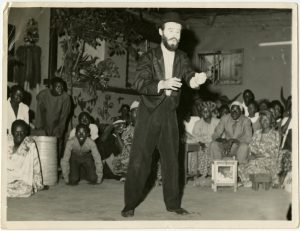
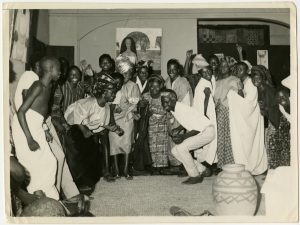
In his capacity as tour manager for the University of Ibadan’s Shakespeare Traveling Theatre troupe, Tom Hebert brought renowned productions—like Twelfth Night, A Midsummer Night’s Dream, and Hamlet among others—to audiences throughout Nigeria. The pictures above illustrate a core tenet of Shakespearian performance: audience interaction, which was anything but lacking in West Africa during the 1960s. In a recent blog post, Hebert recalls that millions of Nigerian students were required to study Shakespeare as part of their secondary education; consequently, audiences numbering in the “thousands would mouth the lines in an audible susurrus” during shows. [1] Hebert also came to understand that British colonialism and an entrenched caste system overshadowed the educational merits of theater: “literate African kids wandering the streets with nothing to do, and nowhere to go.”
In 1964, after two years of service as a Peace Corps Volunteer (PCV), the time had come for Hebert to return to the United States. Addressed “To Whom It May Concern,” a disease identity card (pictured below) marked Hebert’s return:
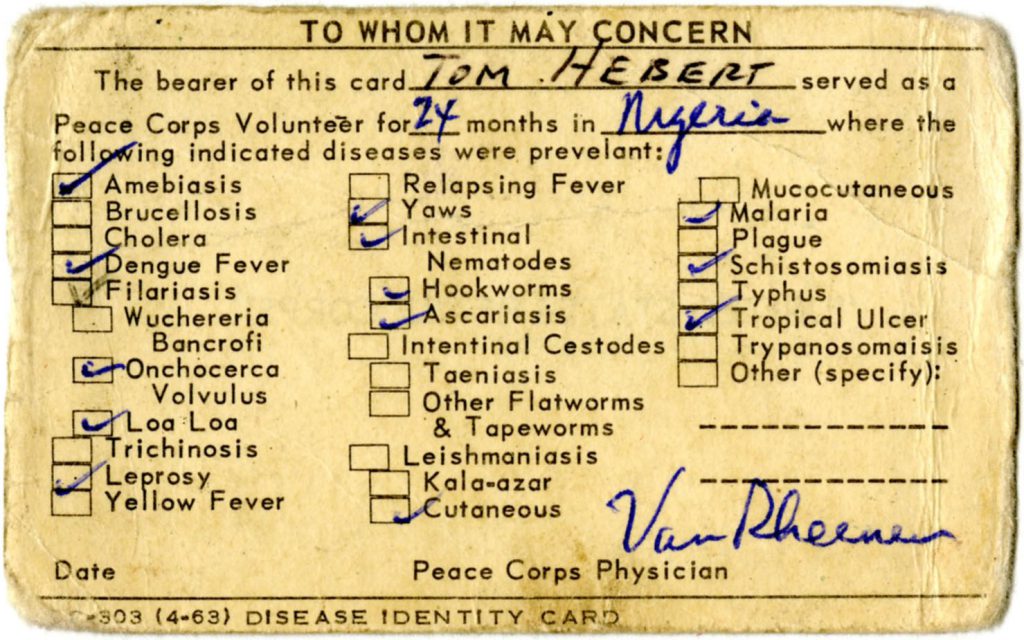
Disease Identity Card, April 1963, Shelf: 12.03.05, Box: “Tom Hebert,” Folder: “Hebert, Thomas L, Nigeria 1962-1964, Training Materials–Supplies and Medical Information,” Peace Corps Community Archive, American University Library, Washington, D.C.
In another example, an unnamed PCV received a similar card upon their return from India in 1968:
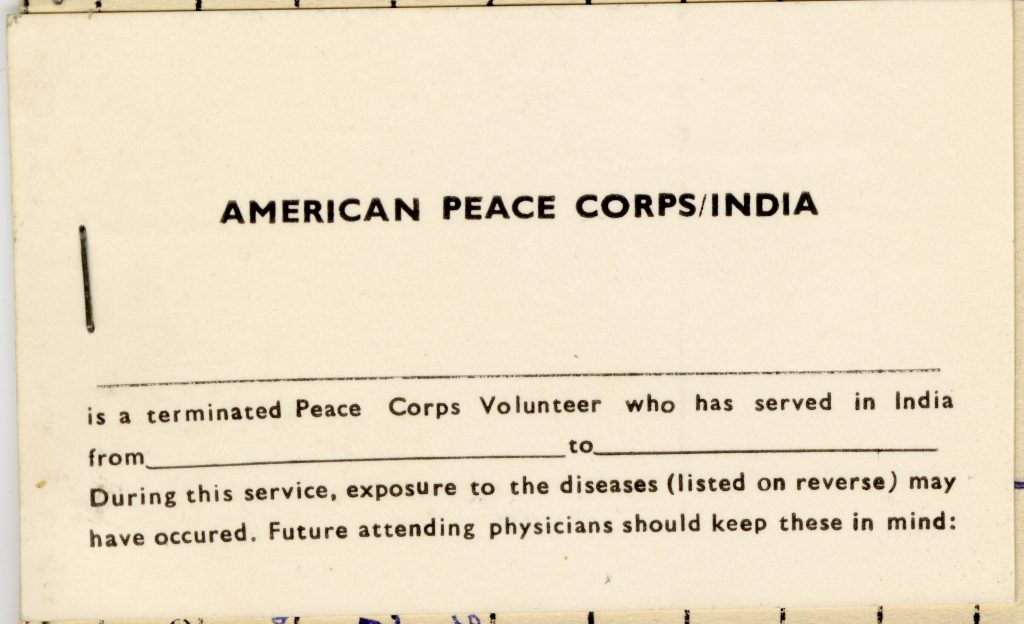
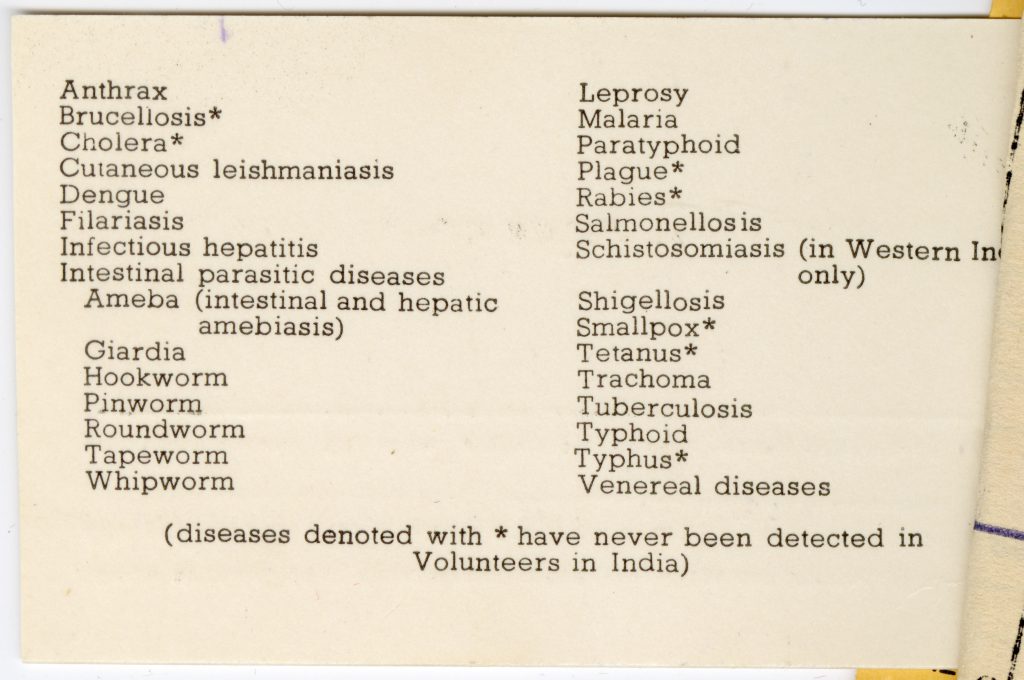
Disease Identity Card, 1968, Shelf: 12.03.02, Inquire for Box & Folder Information, Peace Corps Community Archive, American University Library, Washington, D.C.
These cards were a reminder to PCVs as to the prevalence of disease in their country of service. They were also ostensibly a precautionary measure—designed to warn physicians that the returning PCV might well be a public health risk, in which case subsequent isolation, treatment, contact tracing, and the like would become necessary. [2] Thus, in addition to coping with “reentry, readjustment, and reverse culture shock,” returning PCVs further faced the (remote) reality that they themselves might inadvertently bring lethal pathogens—for which there was little protection against—home to friends and family. [3]
An example: there was no vaccine to combat Dengue Fever—one of several diseases that Tom Hebert was potentially exposed to in Nigeria—in the 1960s. To this day, a “safe, effective, and affordable vaccine” for Dengue Fever remains elusive. [4]
This is not to say that the Peace Corps only took steps to protect PCVs on the back-end of their service. Additional evidence from the Peace Corps Community Archive is revealing; even in the 1960s, the fledgling Peace Corps had a robust front-end health program. It featured preventive medicine (where possible) and pre-departure education designed to reduce disease transmission:
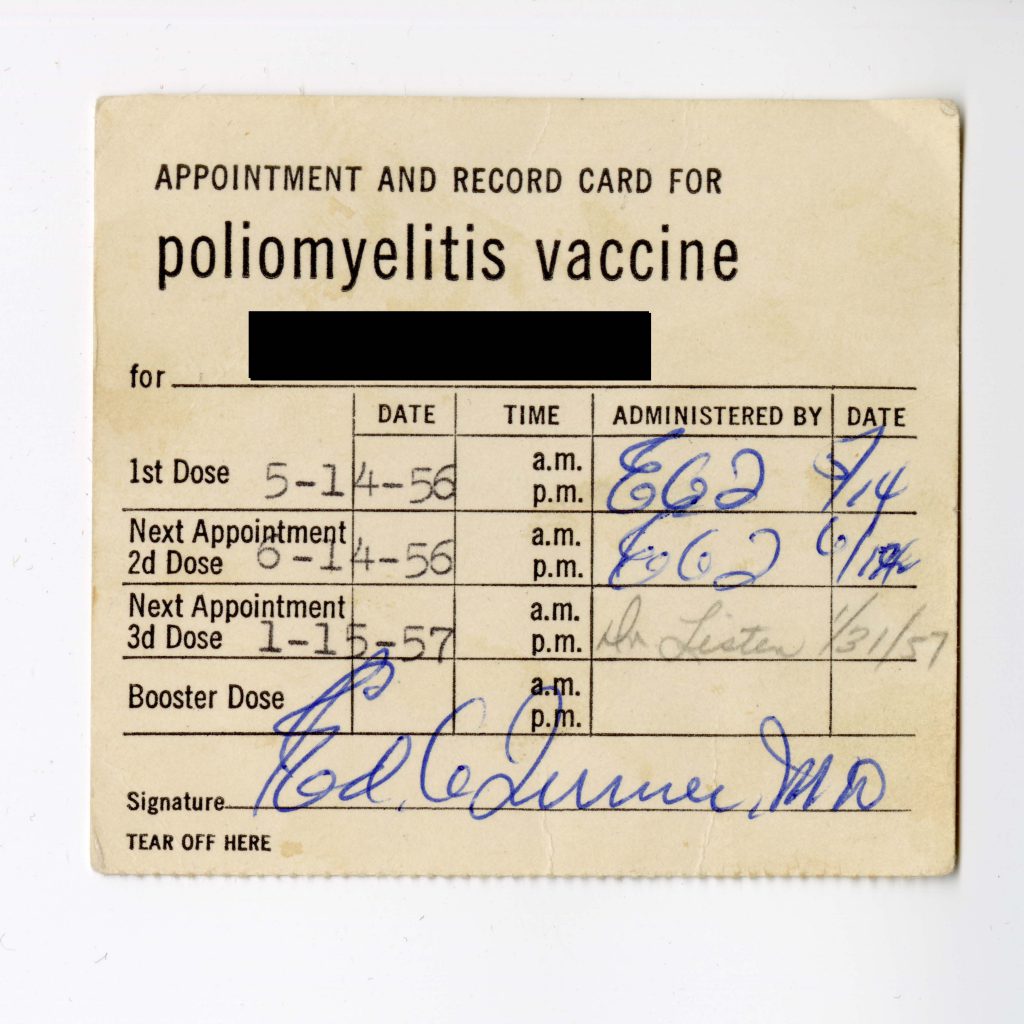
Vaccination Appointment & Record Card, Shelf: 12.03.02, Inquire for Box & Folder Information, Peace Corps Community Archive, American University Library, Washington, D.C.
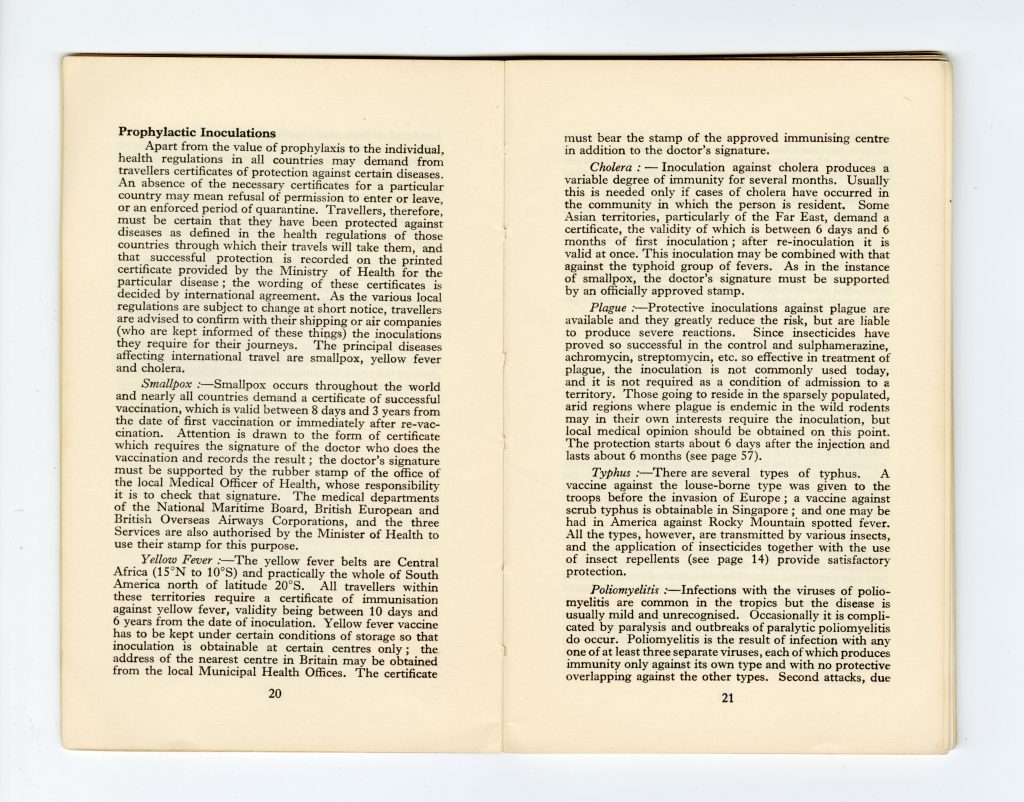
PCV Medicine Book, Shelf: 12.03.05, Box: “Tom Hebert,” Folder: “Hebert, Thomas L, Nigeria 1962-1964, Training Materials–Supplies and Medical Information,” Peace Corps Community Archive, American University Library, Washington, D.C.
In the case that preventive measures such as vaccination and sanitation failed, the Peace Corps also offered active PCVs reactionary treatment in the form of a standard medical kit:
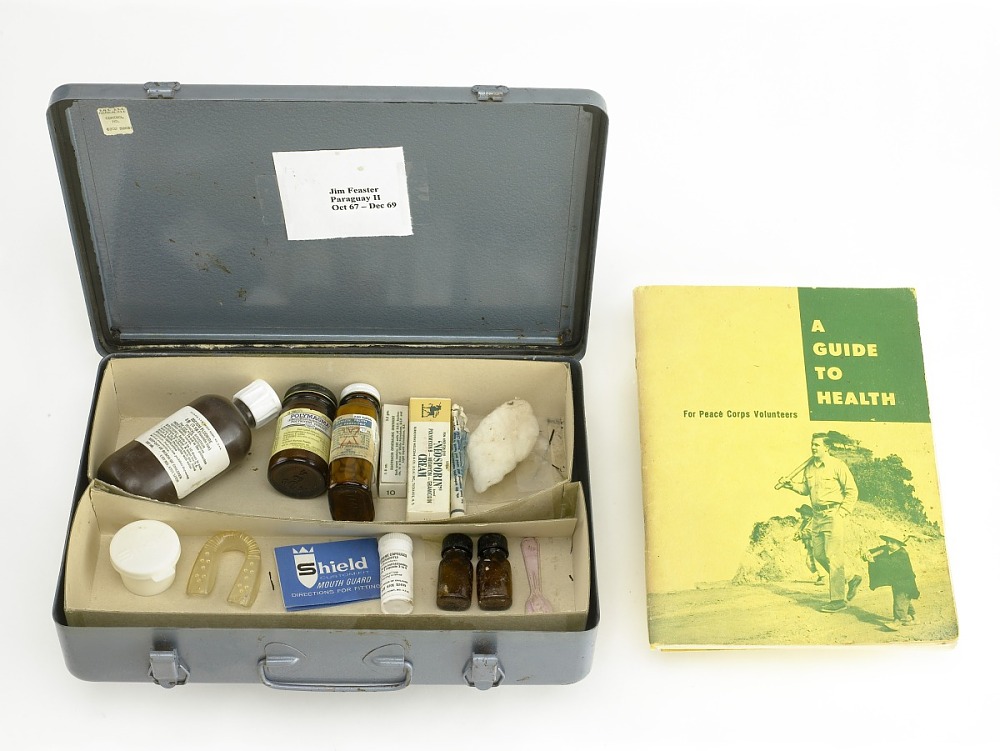
Peace Corps Medical Kit with Health Guide, ID # 2011.0228.36, Transfer from the Peace Corps, National Museum of American History, https://americanhistory.si.edu/collections/search/object/nmah_1412958
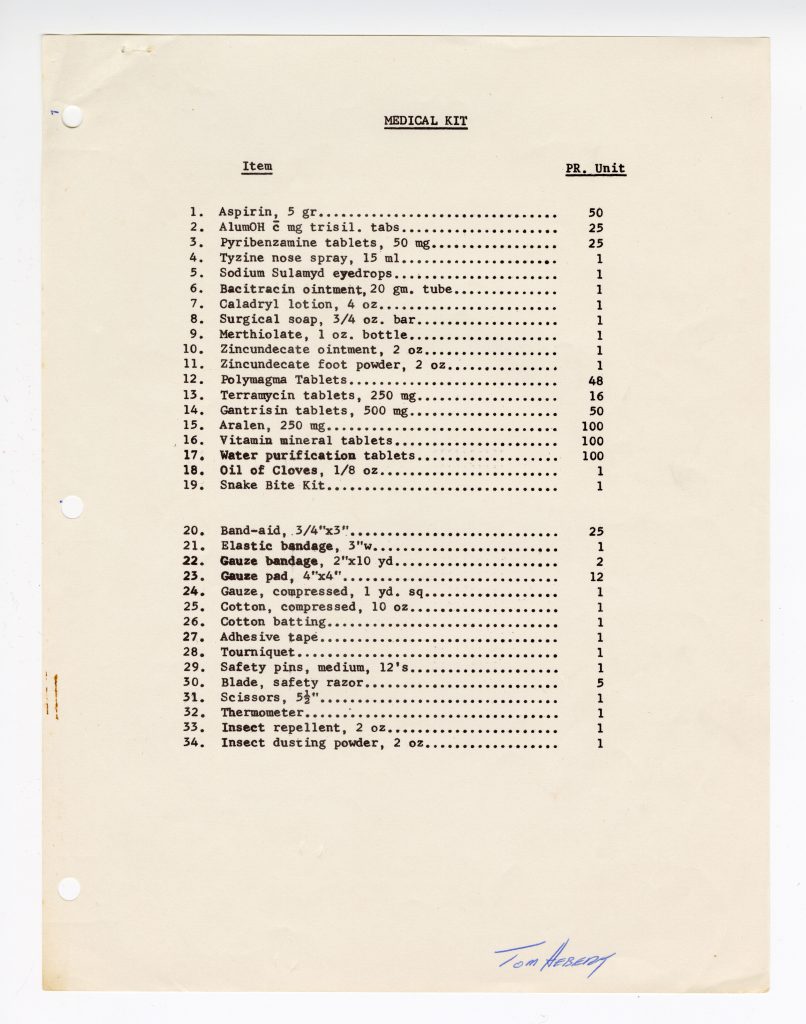
Medical Kit Inventory, Shelf: 12.03.05, Box: “Tom Hebert,” Folder: “Hebert, Thomas L, Nigeria 1962-1964, Training Materials–Supplies and Medical Information,” Peace Corps Community Archive, American University Library, Washington, D.C.
On balance, the health measures enacted by the Peace Corps—from pre-service medical training and vaccinations, reactionary treatment options during service, and disease identity cards upon return—were largely successful. From 1962-1983, 185 PCVs died during their service; of those 185, 40 died due to illness. For context: some 235,000 PCVs have served in hundreds of countries since the Peace Corps’ inception in 1961.
Relative to the Nigerians for whom he organized Shakespearean performances, Hebert enjoyed a position of privilege in terms of access to healthcare. For many PCVs, the prospect of becoming ill during service or bringing illness back to loved ones upon return was remote; indeed, the public health infrastructure of their home country, the United States, was robust compared to many countries where the Peace Corps operated.
However, what if the opposite were true? What if returning home was seemingly just as dangerous—if not more dangerous—to the well-being of PCVs? In March 2020, following the onset of COVID-19, this seeming impossibility came to fruition as all active PCVs were evacuated back to the United States. [5]
In a blog post for the Pacific Citizen, Kako Yamada—an evacuated PCV who had been serving in Comoros—recounts the abruptness of being evacuated due to COVID-19: [6]
Our plans for the remaining months or years of service vanished as we collected what we could of our belongings — some able to say their good-byes, others not so lucky.
I had been allotted one hour to pack and say my farewells to my host family — leaving my friends, students, teammates and co-workers in the dust.
Yamada did not fully grasp the gravity of the situation until she embarked on the long flight from Comoros—an island country off the coast of Africa—to her home in New York City:
On my layover in Addis Ababa, I saw people in full body suits; on the subsequent plane, flight attendants wore gloves and asked passengers not to help one another. Upon arrival at Newark Airport in New Jersey, a hollow silence echoed. Welcome home.
She also remembers questioning whether the evacuation was justified, especially because the situation in Comoros appeared much less dire (in terms of infection case numbers) than it did in the United States. It wasn’t until May 1 that the first case of COVID-19 was announced in Comoros; by then, in the month and a half since she had returned to New York, “there had been 304,372 reported COVID-19 cases in New York, a number that equated to half the population of Comoros.”
Moreover, in the United States, a crisis of public trust emerged—only compounding the threat posed by COVID-19. The situation rapidly devolved into a multifaceted culture war, one which pinned public health experts against conspiracy theorists and their sympathizers in government leadership. Anecdotal evidence and misinformation were disseminated to discourage mask wearing and promote unproven miracle cures, among other flashpoints of the culture war.
Chloroquine and hydroxychloroquine, for example, were frequently touted by right-wing conspiracy theorists as miracle drugs in the fight against COVID-19. With the benefit of hindsight, and given that credible public health experts have historically warned of the untested efficacy of these drugs, we are now certain that neither chloroquine nor hydroxychloroquine are safe to administer to COVID-19 patients. [7] Records from the Peace Corps Community Archive do show, however, the historical—and empirically proven—use of chloroquine as an antimalarial drug in locales such as Senegal:
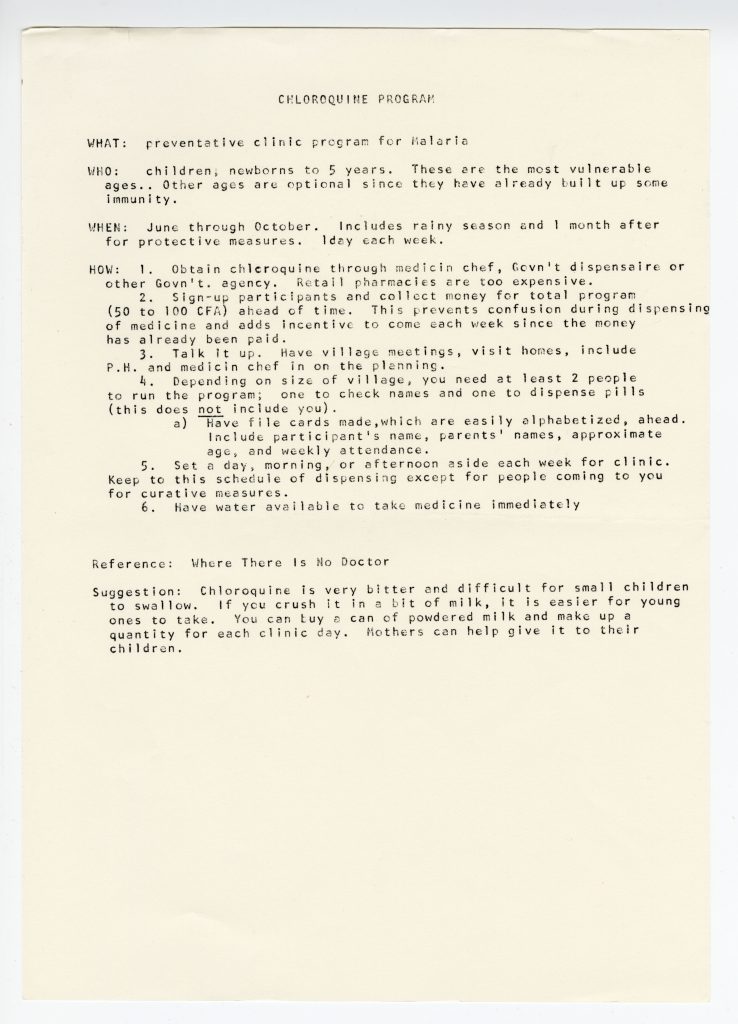
Chloroquine Program Document, Shelf: 12.04.02, Box: “Cherie Lockett,” Folder: “Cherie Lockett, Senegal 1979-1981, Health Care N.D.,” Peace Corps Community Archive, American University Library, Washington, D.C.
Yamada grappled with guilt, for although the situation in the United States appeared dire upon her departure from Comoros, her evacuation ensured a better chance of survival:
It came down to privilege. After months of integrating — through language, food and dances — in the end, I am privileged. In a pandemic, I, as an American citizen and Peace Corps Volunteer, got to fly out to a country with better health care.
I could not escape the fact that I was a volunteer that would disappear if things got bad.
People often ask: how will the history of COVID-19 be written? What will history tell us about our response to a global pandemic? Historians and public historians themselves are asking different, more pointed questions: how will we remember our global response to COVID-19? Who gets to shape the memory of the American experience with COVID-19? Is it the historian’s place to weigh the immeasurable suffering and loss of human life against the resilience and moments of unity that will get us through this? Likewise, who and what dictates how Comorians remember COVID-19? What are the stakes if we omit the lived experiences of those who were and are the most vulnerable to COVID-19? Do public historians have a responsibility to interpret/challenge those actors who downplayed and mismanaged the crisis from its outset? For Yamada, her answer is fairly straightforward:
The situation of a country miles away, often labeled as one of the poorest in the world, is very much mirrored here in the United States.
The characteristics of denial, governmental inadequacies and systematic vulnerabilities of certain social groups over others are paralleled. However, one quality is certainly different: we have the resources, and yet, we dared to fail.
[1] Tom Hebert, “Shakespeare and the Ins and Outs of Education Reform,” Peace Corps Writers, n.d., http://www.peacecorpswriters.org/pages/2001/0109/109cllkheb1.html.
[2] Amy Lauren Fairchild, Lawrence O. Gostin, Ronald Bayer, “Contact Tracing’s Long, Turbulent History Holds Lessons for COVID-19,” The Conversation, July 16, 2020, https://theconversation.com/contact-tracings-long-turbulent-history-holds-lessons-for-covid-19-142511
[3] Peace Corps, RPCV Handbook: You’re on your way Home (Office of Third Goal and Returned Volunteer Services, n.d.), 10, https://files.peacecorps.gov/resources/returned/staycon/rpcv_handbook.pdf
[4] World Health Organization, “Questions and Answers on Dengue Vaccines,” Immunization, Vaccines, and Biologicals, April 20, 2018, https://www.who.int/immunization/research/development/dengue_q_and_a/en/
[5] Jody K. Olsen, “Peace Corps Announces Suspension of Volunteer Activities, Evacuations due to COVID-19,” Peace Corps, March 15, 2020, https://www.peacecorps.gov/news/library/peace-corps-announces-suspension-volunteer-activities-evacuations-due-covid-19/
[6] Kako Yamada, “Welcome Home? From Peace Corps Service to COVID-19 America,” Pacific Citizen, May 22, 2020, https://www.pacificcitizen.org/welcome-home-from-peace-corps-service-to-covid-19-america/
[7] United States Food and Drug Administration, “FDA Cautions Against Use of Hydroxychloroquine of Chloroquine for COVID-19 Outside of the Hospital Setting or a Clinical Trial due to Risk of Heart Rhythm Problems,” July 1, 2020, https://www.fda.gov/drugs/drug-safety-and-availability/fda-cautions-against-use-hydroxychloroquine-or-chloroquine-covid-19-outside-hospital-setting-or
Every volunteer watches as the world at home continues while they are abroad. Some changes are personal, such as the birth of a nephew or the death of a loved one. Other events are huge—where the entire country laments at the news of a disaster.
Thousands of miles away, Peace Corps Volunteers received news that shook the nation, and even the world. Radios broadcast the assassination of President John F. Kennedy and his brother Senator Robert Kennedy, the destruction of the 1992 Los Angeles riots, and the deadly attacks on September 11, 2001. While distance can lend space to heal from tragedy, it also cuts PCVs off from important support systems.
These six volunteers watched American events unfold from the non-military, external broadcasting program Voice of America, newspapers, and letters from their families and friends. They reflected on national elections, assassinations, and devastating disasters—often remarking on their isolation and questioning their faith in humanity.
“I don’t see much in the future.” Assassination of John F. Kennedy- November 22, 1963
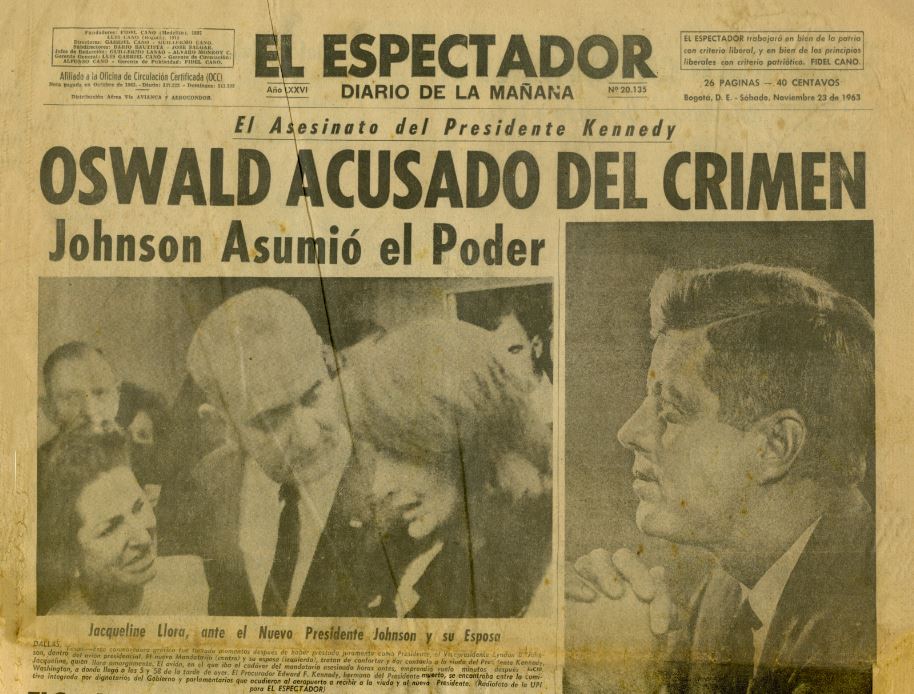
Headline in Colombian Newspaper on November 23, 1963. Friends of Colombia Collection, Peace Corps Community Archives.
Geer Wilcox learned about the assassination of John F. Kennedy’s while living in the Dominican Republic. As a blind Peace Corps Volunteer, Wilcox relied on hearing the news from neighbors reading newspapers and the radio. He often commented on the state of American politics or the Vietnam War as he listened to the international news broadcast, the Voice of America. When the news of Kennedy’s death broke, Wilcox reported feeling apprehensive of Lyndon Johnson and the future.
Wilcox expresses his shock in a recorded letter home to his parents on November 30, 1963:
Rene Cardenas was in Colombia when the news broke. She processes the aftermath of Kennedy’s death in a poem titled “Yesterday November.”
The address for sorrow
two inches away
the president has been killed
the clouds of wet season
the earth’s longest pity
everything is split time
a piece of wood
pulled apart at the grain
in an apartment in Cucuta
han asesinado a Kennedy
bells toll for three days
sent notes of condolences
to the wall
by my bed
two inches away
from my face.
Additional reactions to President Kennedy’s death are recorded here.
“What a sick society I left.” Assassination of Senator Robert Kennedy- June 6, 1968
Even as he served in Western Samoa, Arthur Aaronson wrote home often about the 1968 Democratic candidates Senator Robert Kennedy and Eugene McCarthy. He heard about the attack on Senator Kennedy from other PCVs and the radio, which gave details about what happened in the hotel kitchen of the Ambassador Hotel. Aaronson wrote to his parents that evening:
I heard the news about Kennedy Wed. night as I was walking back from a dance with my sister. Two volunteers walked by and they told me the news. I was stunned. Then when I heard it on the radio that night I could only cry as the radio gave the details. The death of Martin Luther King didn’t hit as hard. Probably because Kennedy was on the way to being the next President. All the wealth and power of the U.S., it does not hide the fact of what a sick society I left.
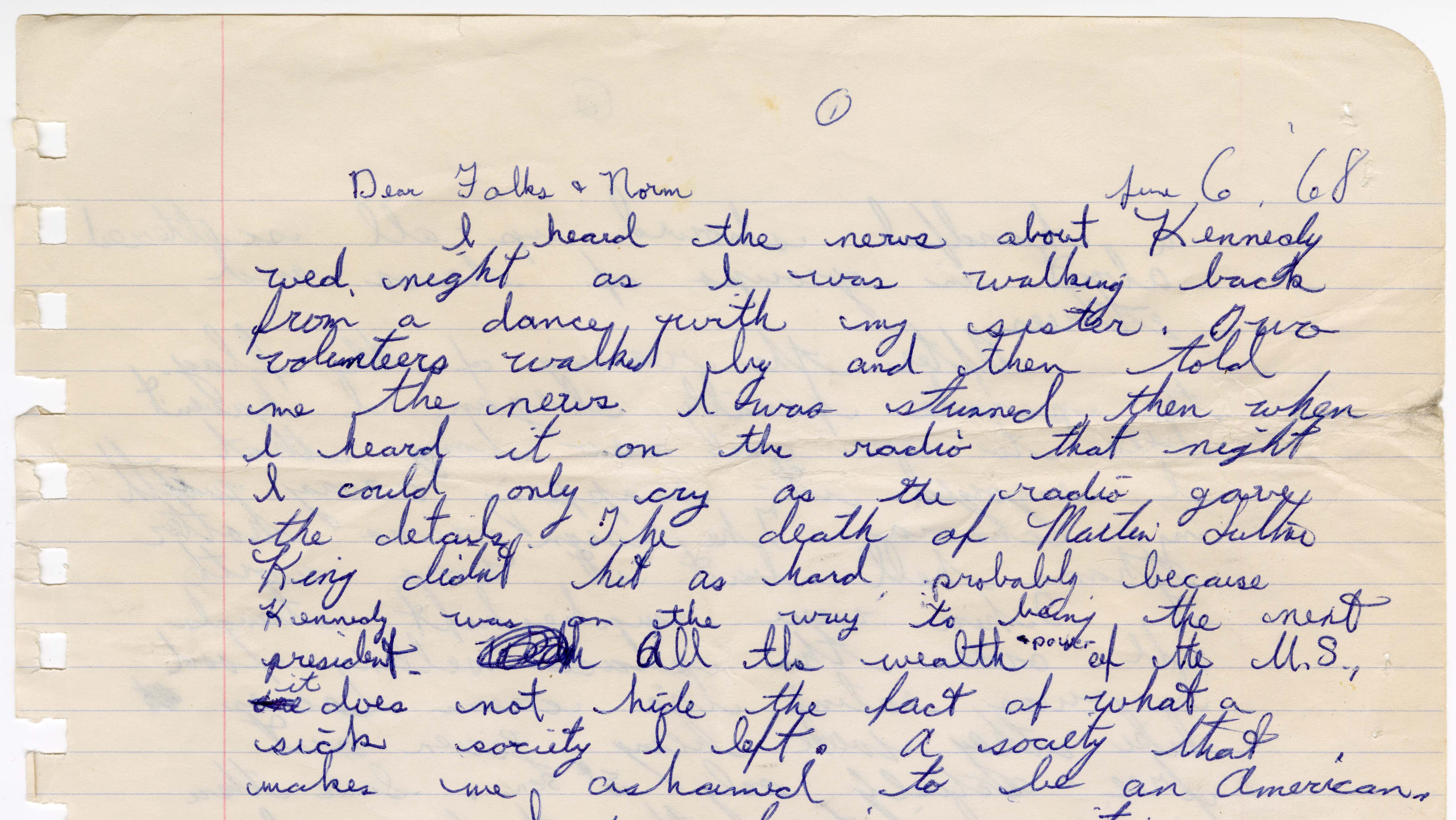
Aaronson’s letter home on June 6, 1968. Peace Corps Community Archives.
“I can only hope something good comes of all this.” Rodney King Riots- April 29, 1992

Photograph submitted by Dark Sevier on January 1, 2008. Flickr Creative Commons
In March 1991, a bystander recorded a video of four L.A. police officers beating Rodney King—a black motorist—for a reported 15 minutes as other LAPD officers looked on. Despite the video evidence, the court found the four officers “not guilty” of excessive use of force on April 29, 1992. Fueled by this acquittal and years of racial and economic inequality, riots broke out around South Los Angeles, raging for 5 days.[1]
Tina Singleton watched the riots transpire as she completed her volunteer staging in Cameroon. She had lived and worked in San Francisco for 10 years before joining the Peace Corps in 1992. Singleton followed the events and devoted several diary entries to her thoughts:
30 Avril 1992
Just heard about the 4 police officers in the Rodney King Case being acquitted—I was sad and in shock. I just don’t understand how the jury came to that conclusion—it blows me away—I’m so upset. It’s hard to concentrate on anything. I’ve had a few good cries. Also heard about the rioting in L.A.—it’s awful—but I understand the reaction. This was such a blatant disregard for justice and Rodney King’s civil rights—what a disgrace—and with all the evidence—a videotape and all the tapes of the officers’ conversations—and they still got off. Rose-Marie and Soyeon and I were/are very shaken by this. The U.S. is getting worse by the minute. It makes me not want to even go back to the U.S.—I’m happy I’m here for two yrs.
1 Mai 1992
It’s gotten worse—protesters are now in San Francisco, Atlanta, Dallas—they’ve blocked the Bay Bridge again. Can’t believe all this is happening—1992 and we’re having race riots. I can only hope something good comes of all this—the rioting, the looting—I almost wish I could pick up a phone and call Jean and Peggy. This was my first taste of what it’s going to be like when a serious situation arises in the U.S.—I felt pretty cut off. I see what volunteers mean when they say the shortwave will become your best friend. We listened to is as much as possible. What I wouldn’t do for a newspaper right now. This is the weekend we stay with a Cameroonian family—should be interesting. Though I’ve been upset and crying today about this Rodney King episode. I just can’t believe this has happened—It still blows my mind.
Lundi, 3 Mai 1992
Heard on the news this morning about L.A.—2,000 people hurt, 40 dead, Bush has declared L.A. a disaster area. I guess he’s going to LA this week to see the damage—don’t have figures on the other sites—saw the news this weekend on TV at my family. L.A. looks pretty bad—fires everywhere. Saw Rodney King—he was so upset. I felt so bad for him. He kept saying “it’s not right, this isn’t right—we only want our day in court.” He was pretty devastated about all the violence as well—he spoke about the people not being able to go home to their families. He looked so devastated—I felt so bad for him. He just looked so bad—so down. Like I said before—I hope something good comes of this.
5 May 1992
Well, last nite was a real shit nite. Sebastian brought newspapers from Dovala—A USA Today and some French language papers. I was not ready for what I saw—the pictures really floored me. I knew it was bad in LA, but I didn’t know how bad. The man [Reginald Denny] being dragged from his truck and shot—then robbed. The white man who was on the ground and being kicked by 3 Black men—it’s so sick. I’ve got such a bad headache. I can’t stop thinking about all this madness. This whole thing has me wondering why I’m here and not at home doing something to help the situation there.
It’s so hard to concentrate on my French—we’re here for only 2 more weeks. I am worried about my French—it doesn’t seem so important anymore. I hope I’m not going to feel like this for a long time—I know if I do, I’d leave, and I don’t think that’s what I want. I’m just so confused now. People here seem to think things will be better after this, but I don’t think so. I’m feeling pretty pessimistic at this point—I’ve no other reason to feel otherwise. Soyeon and I had a good cry last nite. We’re both in a daze, as is Rose-Marie. Heard on the news this A.M. that 10,000 businesses were lost as well as at least that many jobs—which is something we can’t afford to lose.
Soyeon and I are calling home tomorrow—I can’t wait. I really need to talk to the folks—I might call Jean too. I’m not sure—it will be great to at least talk to Mom and Dad. It’s sounds like Mom’s feeling a little lost with me gone. It’s weird for me not to be able to pick up the phone. I was dying to talk to them last night—tomorrow will come soon enough.
— T
As a Black woman who lived in California—or rather, anywhere in the United States—Singleton was shocked and devastated by reoccurring injustices in the United States. Cut off from her friends and family and relying only on news from the radio and infrequent newspapers, she found support from two other Black volunteers—Soyeon and Rose-Marie—to process the injustice of the trial and the impact of the riots.
Despite her initial desire to return home, Singleton spent 3 years in Benin, West Africa as a Health Educator. She became an international development worker for over 20 years and launched a program called Transformation Table, devoted to promote sharing a meal and culture between communities, in November 2016 in Charleston, SC.
“We shortly came to the realization that life had changed.” September 11, 2001
Living in a remote village in Zambia, Lara Weber was listening the the Voices of America when the voice over the radio reported, “”A… plane… has… hit… the… World… Trade… Center… in… New… York… City…” With no electricity, internet, or phone within a day’s drive, Weber explained feeling detached as more and more reports rolled in. She also worried about her father, who occasionally visited the Pentagon on business.
The weeks that followed were strange in that I had no Americans to talk with at all. Some of the elder men of the village visited me one day. They wanted to understand the news better, and their questions were interesting. One man wanted to know more about the Twin Towers and Manhattan. Why did so many people need to live and work on top of one another in such vertical spaces — had we run out of land in the rest of America? I tried to answer, but what I said felt inadequate and the whole idea of New York suddenly made no sense. Why did we pile into cities like that?
Rhett Power’s experience was a little different. As a volunteer in Uzbekistan, Power remembers a sense of confusion and urgency following the events, as the Peace Corps determined when to evacuate PCVs in the countries close to Afghanistan.
Power remembers sitting on the floor of a hotel room in the capital with his wife and a group of PCVs after a series of new volunteer training sessions. They were watching CNN when it happened. Power recalls the initial reaction:
I remember it distinctly. My wife and I were…Well, we were in the capital. So we were actually getting ready to go to the airport. I think a group had either come the night before or the day of. We were at a hotel. We were doing a Peace Corps training for new volunteers. There was another married couple there, they were education volunteers—I think he was a health volunteer—but anyway, we were together in the hotel. We were actually loving life because we were in a bed. A really good bed and we actually had two boxes of pizza on the floor. I think we had Orange Fanta and we were beside ourselves. The luxury of it all.
I distinctly remember this—we had a tiny little TV on CNN. You know, again we were watching TV. We didn’t have anything else to watch. But we had one international channel. And, that’s when it happened. And, we were watching it and just—we were just as shocked as everybody else was. I think [we] shortly came to the realization that life had changed. Because we all knew what would happen. Very shortly thereafter—within that hour we knew that something had changed and that something would change.
After three weeks, the Peace Corps evacuated Power and the other PCVs living in the Middle East and sent them back to the United States without reassignment.
As people back home find support within their communities, during times of tragedy PCVs find themselves relying on other Americans, throwing themselves into their work, or talking with their host communities about the implications of the event. Often, these tragedies lead to a renewed sense of faith in the mission of the Peace Corps—as seen in the uptick of Peace Corps applications in the wake of the Kennedy assassinations and 9/11. In other cases, such as the riots in L.A., it can be a reminder of how far we haven’t come.